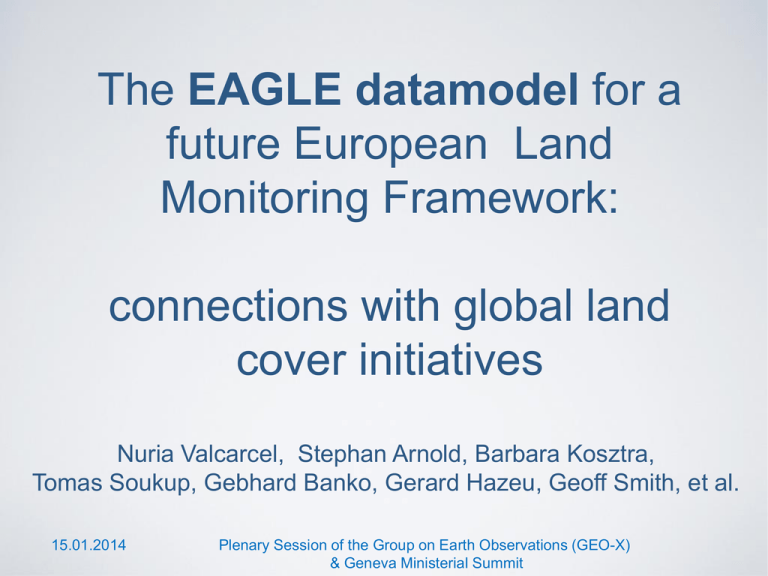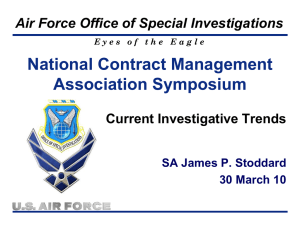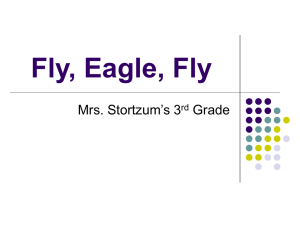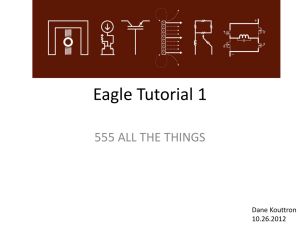The EAGLE datamodel for a future European Land Monitoring
advertisement

The EAGLE datamodel for a future European Land Monitoring Framework: connections with global land cover initiatives Nuria Valcarcel, Stephan Arnold, Barbara Kosztra, Tomas Soukup, Gebhard Banko, Gerard Hazeu, Geoff Smith, et al. 15.01.2014 Plenary Session of the Group on Earth Observations (GEO-X) & Geneva Ministerial Summit CONTENT [0. Current situation] I. EAGLE Group II. EAGLE Concept III. Application Examples IV. Strategy and Outlook [0. Current situation ] • Urgent need for land information at higher spatial and thematic resolutions on European, national and subnational levels • Diversity of end users working with LC&LU data diversity of classification & nomenclatures, according to specific user requirements • CLC (de-facto standard in Europe but with technical and semantic limitations) or LCCS/LCML do not fully suit diverse user requirements [0. Current situation ] Coexistence of national (decentralized /bottom-up) + european & international (centralized/top-down) land monitoring initiatives GEO – GEOSS, Copernicus, LUCAS, and others there is an urgent need for integrating and harmonizing decentralized (bottom-up) + centralized (top-down) approaches for European & Global land monitoring I. EAGLE Group Who is EAGLE? • EAGLE = EIONET Action Group on Land monitoring in Europe • Volunteers from EIONET, mostly NRC land cover, Core members from 10+ European countries Experiences from national & European LM initiatives • Participants overlap between EAGLE and INSPIRE TWGs LC and LU • Conection with Copernicus Land: • Consultations with CLC Technical Team (also active in EAGLE) • Involvement in validation of HRL concepts (specifications and results) II. EAGLE CONCEPT Object orientation: a bread is a bread is a … Object orientation: a bread is a bread is a … Characterization • Outer Appearence • • • • Inner details • • • light dark Other Characters • • • salt wheat / rye water yiest E 510, … Color • • • grainsize density Ingredients • • • • • • weight size shape Bio-certificate Gen-free Use • Food, Alimentation Object orientation: grassland is grassland Classifications • Grassland = pasture = lawn = natural grassland Characterization • Growth structure • • • Growth density • • • Grazing Fodder mowing Sports Management • • • Wet soil Surface water Use • • • • closed sparse Moisture • • • homogenous heterogenous Multiple mowing Single mowing Ecosystem type • Inland marsh Outcome – EAGLE concept Two representations of the same concept (conceptual data model ) • EAGLE data model (Object orientation): UML model as practical implementation and visualization of the conceptual data model • EAGLE matrix: Excel cross table as tool for semantic analysis and comparison of different LC/LU classifications Structure of EAGLE Data Model & Matrix information on landscape separated into three blocks… LAND COVER Components – LCC block Abiotic/Artificial, Biotic/Vegetation, Water LAND USE Attributes and – LUA block Agriculture, Forestry, Industry, Transportation etc. further CHARACTERISTICS – CH status, spatial pattern, bio-physical parameters, habitat types etc. Compatibility with INSPIRE LC&LU DS & LCML (ISO 19114-2) descriptors A.) Land Cover Components [LCC] Describe real landscape elements from pure LC point of view. (Read Matrix from top to bottom.) B.) Land Use Attributes [LUA] Describe territory from pure LU point of view, according to function and socio-economic purpose, linked to INSPIRE (extract shown only) C.) further Characteristics [CH] Characterize landscape with additional properties, flexible extendable list (extract shown only) EAGLE model: from matrix to UML chart EAGLE model: from matrix to UML chart 15.10.2013 EAGLE, EIONET NRC Meeting, Copenhagen, Denmark EAGLE model: from matrix to UML chart 15.10.2013 EAGLE, EIONET NRC Meeting, Copenhagen, Denmark EAGLE model: from matrix to UML chart Structure of EAGLE data model (UML) INSPIRE LC data specs EAGLE data model CH - ... - ... + CH Characteristics ABIOTIC LCCs (Artificial/Natural) LC Unit (1..* LCC) LU Attribute = HILUCS [extended] + CH BIOTIC LCCs (Vegetation) + - ... - ... - ... - ... CH WATER LCCs + - ... - ... - ... - ... © Stephan Arnold II. Application examples – How to use EAGLE data model & matrix ? Describing landscape with EAGLE: „Built-up Area“ Land cover components (LCC): • conventional buildings, • broadleaved trees, • herbaceous plants, • open sealed surfaces Land use attributes (LUA): • permanent residential, • agriculture/production for own consumption, • road network Further characteristics (CH): • soil sealing degree = 35% • built-up pattern = discontinuous, single houses Describing landscape with EAGLE: „Wetland“ Land cover components (LCC): • Inland water bodies, • Reeds Land use attributes (LUA): • nature protected land Further characteristics (CH): • ecosystem type=inland marshes • salinity=fresh water IV. Strategy and Outlook Integration scheme of EAGLE concept C O P E R N I C U S European & Urban HR CLC Global Level Atlas Layers LPIS GEO LUCAS Global LC EAGLE Concept National & Sub-National Level National (A) Land Monitoring National CLC Regional (a) Land Monitoring National (B) Land Monitoring Regional (b) Land Monitoring © Stephan Arnold EAGLE goes public – last Meetings & Presentations 17-18 Oct '12: EIONET NRC Meeting EEA, Copenhagen, DK 18-19 Oct '12: geoland2 Forum8, DK 8-9 Nov '12: ETC SIA Consortium, Malaga, ES 14 Nov '12: German GMES Conference, Düsseldorf, DE 14 Feb '13: HLANDATA Final Conference, Madrid, ES 5 Mar '13: NFP GMES Working Group, Dublin, IR 7 Mar '13: LUCAS Advisory Group Meeting, LUX 15 Mar '13: EAGLE Meeting (post-HELM), Haifa, IL 3-6 Jun '13: EARSeL Symposium (paper), Matera, IT 23 Jun '13: EAGLE Workshop INSPIRE Conf. Florence, IT 18-19 Sep '13: Hungarian Conference on Spatial Information, Gyöngyös, HU 25 Sep '13: GIONET Summer School, Warsaw, PL 17-18 Oct '13: EAGLE meeting (post-HELM), Budapest, HU 5 Nov '13: EAGLE/LCCS tête-á-tête, Wageningen, NL 23-25 Oct '13: European Forum for Geostatistics, Sofia, BG EAGLE Publications EARSeL: Arnold S., B. Kosztra, G. Banko, G. Smith, G. Hazeu, M. Bock, N. Valcarcel Sanz (2013): The EAGLE concept – A vision of a future European Land Monitoring Framework. In: Rosa Lasaponara (Editor): EARSeL symposium proceedings “Towards Horizon 2020”, June 2013, Matera, Italy. (download from EAGLE web site) FP7 HELM: - Report on Task 4.3 “Enhancing the European Land Monitoring System – collection of criteria for a future data model” - HELM Booklet with executive summaries of all tasks EAGLE activities I (EEA umbrella) Foreseen further development of data model regarding … - Temporal aspects: several time dimensions (long-term continuous trends, singular permanent changes, season/cyclic changes, daily/rhythmic „changes“) future availability of high frequent multi-temporal imagery (LANDSAT8, Sentinel2, GEOSS) - Scale aspect: vertical concept for different level of details (LoD) - Refinement of model components (UML-classes), attributes and characteristics 15.10.2013 EAGLE, EIONET NRC Meeting, Copenhagen, Denmark EAGLE activities II (EEA umbrella) • Closer conceptual exchange with ISO LCML / LCCS, CEN • Synergetic requirements and cooperations between land monitoring and statistical community • Involve more key stakeholders interests (EEA, Eurostat, DGs): heading for contribution from EAGLE data model to future land monitoring system 2015 onwards • Fostering technical interoperability (mainly tackled by INSPIRE) and thematic harmonization • EAGLE workshop 2014 (1st / 2nd quarter) 15.10.2013 EAGLE, EIONET NRC Meeting, Copenhagen, Denmark Key Messages The EAGLE concept….. • allows semantic comparison and translation between different classification systems • provides a flexible framework for integration of different land related datasets (postum, recent, future) • fosters harmonisation of national & European & global LM activities through provided data model following bottom-up approach Thank you for your attention ! Further Information © Barbara Kosztra sia.eionet.europa.eu/EAGLE Contact us for questions or feedback eagle@geo-concept.de



